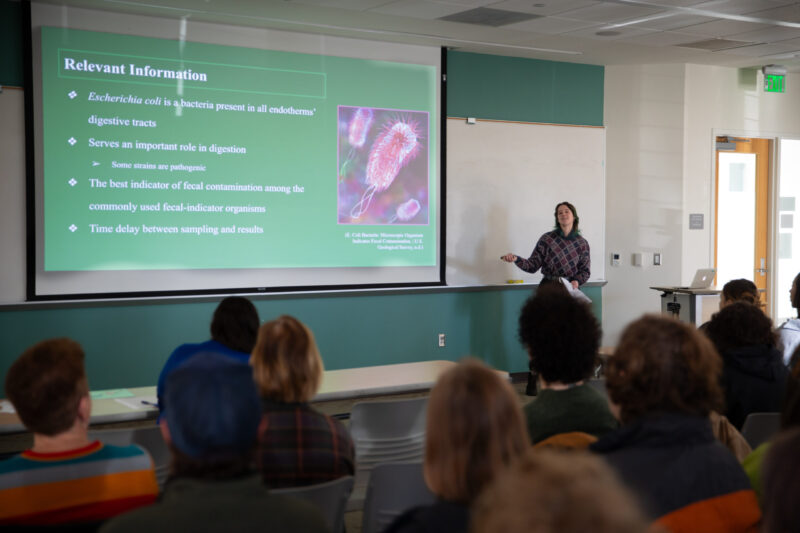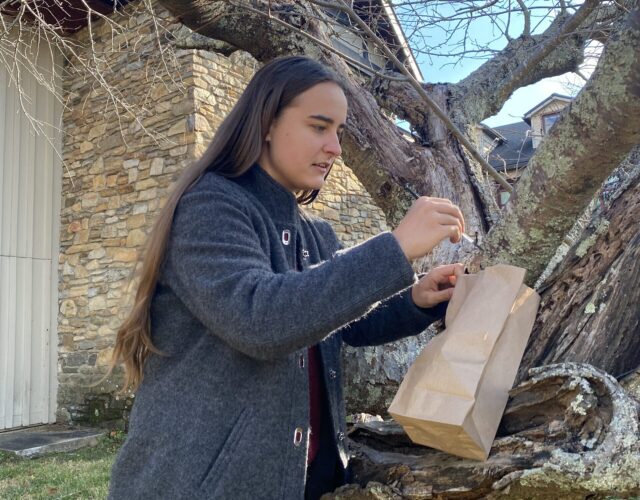
At the end of each fall semester, Warren Wilson College hosts a Winter Showcase as a celebration of students’ academic accomplishments. The event features senior capstone projects, Natural Science Undergraduate Research Sequence (NSURS), presentations on first-year seminars, and other final projects from the semester.
Below are a few projects presented at this year’s event:

Mathilde Pineau
Investigating Autofluorescence in Tardigrades by Mathilde Pineau
Mathilde Pineau, an international student from France, researched autofluorescence in tardigrades (commonly known as “water bears”). Her goal for her NSURS project was to develop a digestion technique for cuticle isolation, and to measure relative fluorescence in digested cuticle vs. shed cuticle. As part of her work, she discovered a new species of tardigrade! It will be named after Warren Wilson College, Milnesium warrenwilsoni. During her time as an undergraduate student, Mathilde co-authored a paper on autofluorescence with Dr. Paul Bartels and Dr. David Coffey.

Blue Savedge
Firestorm: A Queer Firefighter Training Program by Blue Savedge
Blue Savedge was born into a family of firefighters. Both of their parents were wildland firefighters, and Savedge has worked as a forestry technician and burn crew for The National Conservancy. In the field, Savedge didn’t see much representation of openly queer firefighters. For their capstone project, Savedge created a queer firefighter training program. Savedge is an Outdoor Leadership Major and crew leader of the Ecological Landscape crew.

Harlow Higgins
Turbidity as an Indicator for the Presence of E. coli by Harlow Higgins
For their senior capstone project, Harlow Higgins researched whether turbidity (or the clarity of water) could be an indicator of E. coli. They sampled the Swannanoa River over a year and analyzed the samples to determine whether there is a relationship between turbidity and E. coli, and how the findings compared to findings by the state. Upon graduation, Higgins has a job lined up with the Department of Environmental Quality (DEQ).

Aurora Rose
An Exploration of Social Preference in Autistic and Non-autistic Individuals by Aurora Rose
For her senior capstone project, Aurora Rose conducted interviews to research social preferences of autistic and non-autistic individuals. Her research, based on the double empathy theory, explored differences between autistic and non-autistic communication styles. Her research found:
– Autistic people prefer to connect through the sharing of interests and passions, whereas non-autistic people prefer to connect over shared experiences.
– Both groups preferred direct communication.
– Autistic people preferred small gatherings over parties.
– Both groups said they felt excluded from others.
Aurora’s research was influenced by her own experience as an autistic person. Aurora is a senior Psychology major with a double minor in Neuroscience and Biology.

Inspiring Kids as Readers First Year Seminar
First Year Seminar: Inspiring Kids as Readers
Warren Wilson students in Dr. Julie Wilson’s First Year Seminar “Inspiring Kids as Readers” spent last semester as reading buddies to second graders in Sarah Torrey’s class at W.D. Williams Elementary in Swannanoa. Each Warren Wilson student wrote a book in collaboration with their reading buddy, based on their interests and ideas. The elementary students also took a field trip to campus to see the sound lab, farm, gym, soccer fields, and to eat in the dining hall. Relationships make readers!
First Year Seminar: Networked Landscapes
In the Networked Landscapes class, students worked with eighth grade science students at Owen Middle School to install sensors around the school’s grounds to collect environmental data every hour. The Warren Wilson students and eighth graders then analyzed the data. Through this process the groups learned how important it is for there to be human intervention in data collection.
First Year Seminar: Nature RX
Students learned how to facilitate healing spaces in nature through participating in a variety of activities outdoors. In Nature RX, Warren Wilson students partnered with Evergreen Charter School to maintain their campus trails and worked with the students to promote health by taking them on a hike. While on campus they had their classes everywhere including Dogwood Pasture and in the river! One group of students created a coloring book of campus landmarks.
First Year Seminar: Healthy People, Healthy Places
In Healthy People, Healthy Places, the class worked with two nonprofits. At Root Cause Farm they gardened and packaged produce while at Bounty and Soul they helped set up different distribution methods to ensure local residents had access to healthy food. Food insecurity impacts over 30,000 residents of Buncombe, the county these nonprofits serve.